Navigation
Install the app
How to install the app on iOS
Follow along with the video below to see how to install our site as a web app on your home screen.
Note: This feature may not be available in some browsers.
More options
Style variation
-
Congratulations cowski on being selected by the Eng-Tips community for having the most helpful posts in the forums last week. Way to Go!
You are using an out of date browser. It may not display this or other websites correctly.
You should upgrade or use an alternative browser.
You should upgrade or use an alternative browser.
24-level building tower fire in West London 33
- Thread starter Ingenuity
- Start date
- Status
- Not open for further replies.
JedClampett
Structural
A couple of observations:
1) If this would of happened in the second or third world, I would of thought, "...well at least we have good building codes and it can't happen here." This is the second bad fire incident (Oakland, December, 2016) in very recent memory in code conscience areas. So we (myself included) shouldn't get cocky.
2) To add to some of the posters above, when I read that this was public housing, it didn't surprise me. I just hope that whoever made the decision to use this junk, didn't think, well these people are lucky to have a place at all, a cheaper cladding is fine.
1) If this would of happened in the second or third world, I would of thought, "...well at least we have good building codes and it can't happen here." This is the second bad fire incident (Oakland, December, 2016) in very recent memory in code conscience areas. So we (myself included) shouldn't get cocky.
2) To add to some of the posters above, when I read that this was public housing, it didn't surprise me. I just hope that whoever made the decision to use this junk, didn't think, well these people are lucky to have a place at all, a cheaper cladding is fine.
Guest102023
Materials
A report I heard explained that the material in the aluminium cladding was not so much an issue as the design. The space between the cladding and the outer wall acted as a near-continuous chimney, allowing heat and flames the rise up the building sides very rapidly.
bbc.co.uk and theguardian.com will have up-to-date information.
"If you don't have time to do the job right the first time, when are you going to find time to repair it?"
bbc.co.uk and theguardian.com will have up-to-date information.
"If you don't have time to do the job right the first time, when are you going to find time to repair it?"
brimstoner... and the insulation was combustible, too and the aluminum was a replacement for metal with a zinc coating... The replacement was undertaken for energy savings... with the several million dollars (euros, pounds, or whatever) it would have taken centuries for 'pay back' (unless you live in Ontario, where the return period could be a couple of weeks)... [Change]The Architects replaced a safe, non-combustible cladding with an unsafe system that may have cost 100 people their lives.
There are likely 'stack' issues that brought the fire and heat to the interior of the structure... I'm not sure sprinklers would have helped, but, they wouldn't hurt. The single stairwell was not good.
In Canada, we are going for multi-storey buildings using wood construction. I hope that the cladding is not as flammable.
Dik
There are likely 'stack' issues that brought the fire and heat to the interior of the structure... I'm not sure sprinklers would have helped, but, they wouldn't hurt. The single stairwell was not good.
In Canada, we are going for multi-storey buildings using wood construction. I hope that the cladding is not as flammable.
Dik
LittleInch
Petroleum
Brimstone.
Look at the design I posted earlier. This really was a disaster waiting to happen. Death role will be close to 100. Very few of the missing will be found alive somewhere.
Remember - More details = better answers
Also: If you get a response it's polite to respond to it.
Look at the design I posted earlier. This really was a disaster waiting to happen. Death role will be close to 100. Very few of the missing will be found alive somewhere.
Remember - More details = better answers
Also: If you get a response it's polite to respond to it.
I will be curious to see what an investigation of the supply chain reveals. Photos after the fire show much of the spandrel panel insulation charred but still in place. The Columns are mostly bare. Consider that the spandrel panels were a custom profile, while the columns have more of a boilerplate fabrication. Did the manufacturer sub out the production of the column profiles or is the production line for the more standardized shaped cladding manned by less experience personnel? This photo sticks me as important in understanding what happened. It is when the sky is still in a state of darkness. Here are some time references.
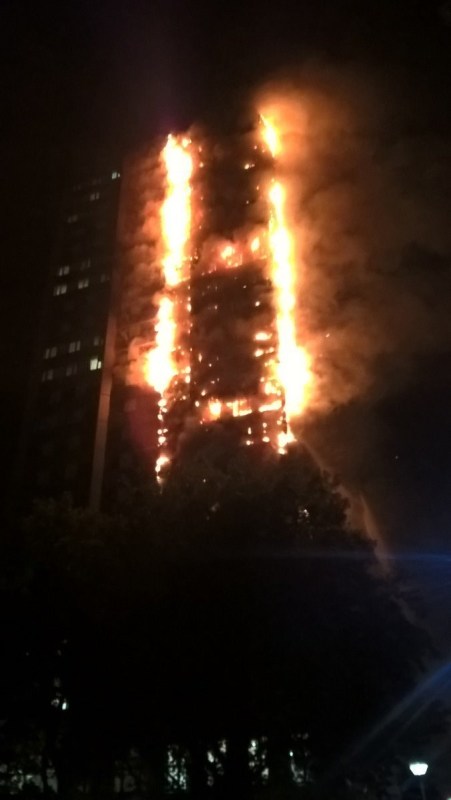
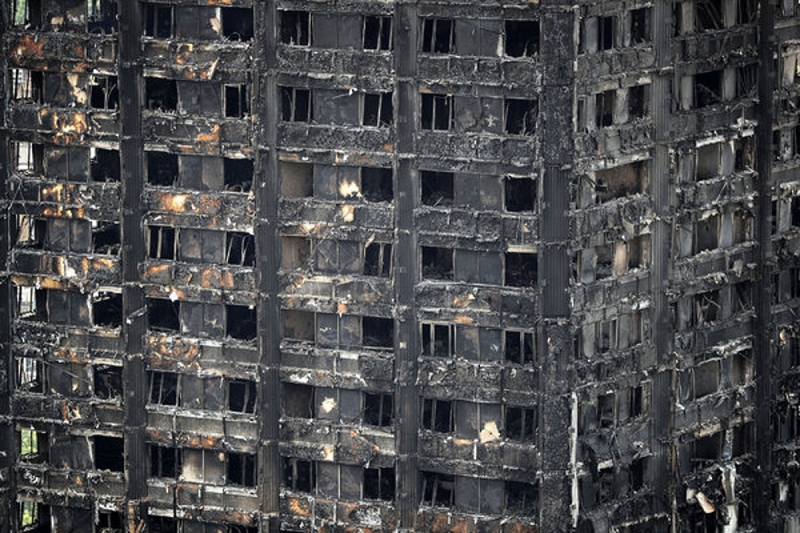
Astronomical twilight begins 01:00:01
Nautical twilight begins 02:41:57
Dawn - civil twilight begins 03:55:26
Sunrise: 04:42:45


Astronomical twilight begins 01:00:01
Nautical twilight begins 02:41:57
Dawn - civil twilight begins 03:55:26
Sunrise: 04:42:45
Well something appears to have changed from the drawing board to the time of installing the cladding. It appears the number of/or location points of the column cladding changed. The susceptibility to fire damage between the column cladding and the spandrel cladding also seems dramatically different. In one photo of falling/burning debris there appears to be a plastic film as a remnant of a panel.
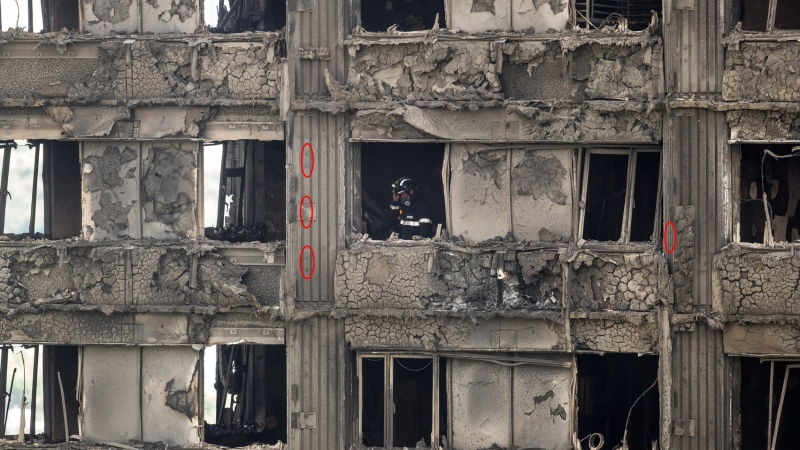
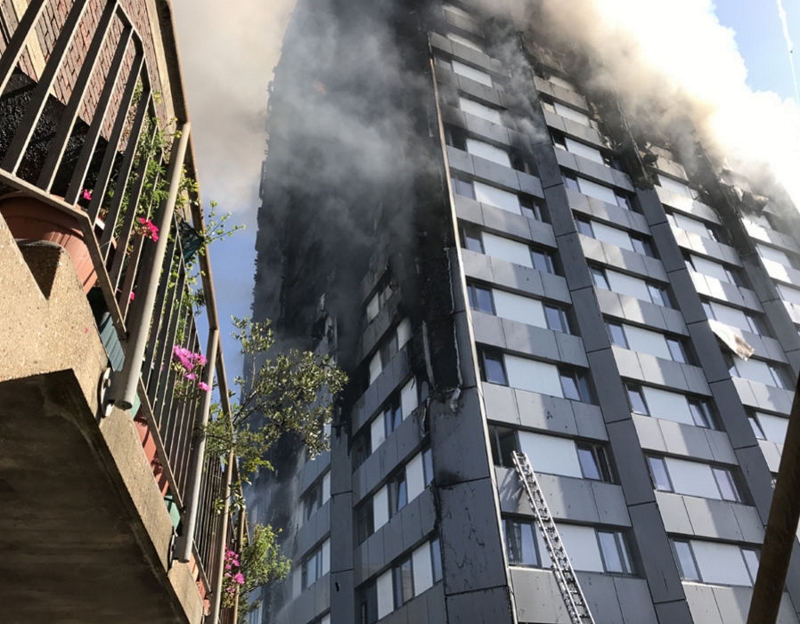
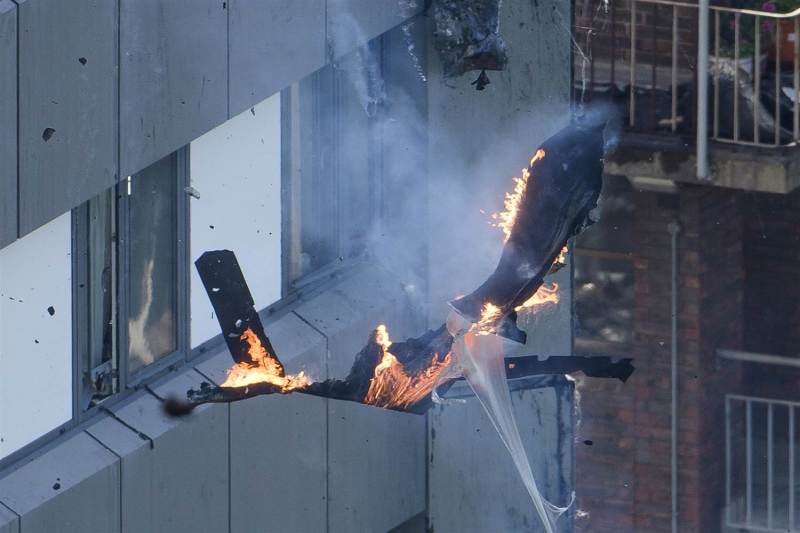



-
1
- #69
Compositepro
Chemical
The plastic film was created by molten plastic that resolidified as it was falling through air. In videos of the fire you could clearly see burning molten plastic pouring from the facade, and also strings and sheets of resolidified plastic floating in the wind.
What part do you think was plastic? Could that not be aluminum?
The section posted above shows the composite cladding connected to the concrete by some sort of bracket, presumably installed through the insulation. I wonder how that was done. And what held the insulation in place until it was restrained by the cladding? Glue? That is a rough architectural detail, done by someone who didn't know how it was going to be put together. I wonder (again) if there were shop drawings.
Maybe Ingenuity can find them. He seems to be our best detective.
The section posted above shows the composite cladding connected to the concrete by some sort of bracket, presumably installed through the insulation. I wonder how that was done. And what held the insulation in place until it was restrained by the cladding? Glue? That is a rough architectural detail, done by someone who didn't know how it was going to be put together. I wonder (again) if there were shop drawings.
Maybe Ingenuity can find them. He seems to be our best detective.
-
2
- Thread starter
- #72
hokie66 said:Maybe Ingenuity can find them. He seems to be our best detective.
Trying to 'dig deep' via Google, but shop drawings are tough to source. I have also noticed that several websites have shut down - for example, the refurb project architects (Studio E, LLC) shut their website down immediately following the disaster. I think the Royal Borough of Kensington and Chelsea has also restricted access to parts of the Glenfell Towers documentation, possibly from legal advice.
I did find this document authored in February 2016 from the UK forensic architects of PROBYN MIERS entitled:
'Fire Risks From External Cladding Panels – A Perspective From The UK' ==> Link
Some interesting extracts: The red-colored bold emphasis is by me.
PROBYN MIERS said:3.3 Interaction with the external envelope
It is at this stage of the fire scenario that the fire performance of the complete external cladding system, including any fire barriers, is critically important. Once flames begin to impinge upon the external fabric of the building, from either an internal or an external source, there is the potential for the external cladding system to become involved, and to contribute to the external fire spread up the building by the following routes.
3.3.1 Surface propagation
The reaction to fire characteristics of the materials used within the external cladding system will influence the rate of fire spread up the building envelope by way of the surface of the external cladding system.
3.3.2 Cavities
Cavities may be incorporated within an external cladding system, or may be formed by the delamination or differential movement of the system in a fire. If flames become confined or restricted by entering cavities within the external cladding system, they will become elongated as they seek oxygen and fuel to support the combustion process. This process can lead to flame extension of five to ten times that of the original flame lengths, regardless of the materials used to line the cavities. This may enable fire to spread rapidly, unseen, through the external cladding system, if appropriate fire barriers have not been provided (Figure 6).
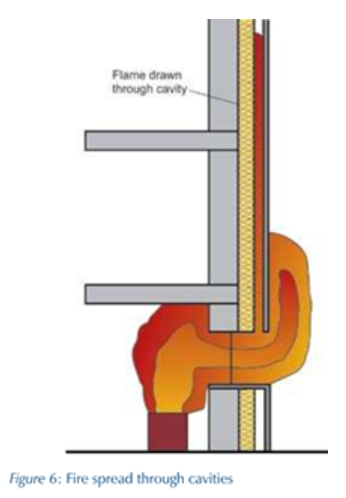
PROBYN MIERS said:Fires in external cladding
At the same time as concern was developing regarding composite panels, another hazard emerged in connection with external rainscreen cladding:
Knowsley Heights fire 5 April 1991
An apartment block in Knowsley Heights, Liverpool, was the subject of an overcladding system in 1989-90. The scheme comprised overcladding panels fixed to vertical sheeting rails, all of which extended to ground floor level. [7]
“A fire was started deliberately in the rubbish compound outside the 11-storey apartment block. The fire spread rapidly through a 90 mm gap between the building’s rubberised, paint-covered concrete outer wall and a recently installed rain screen cladding (with limited combustibility). The fire spread all the way to the highest floor and seriously damaged the outer walls and windows of all the upper floors. …” [8]
The remedial works involved the introduction of horizontal cavity barriers at each floor level.
racookpe1978
Nuclear
Summer time in London, if it is as hot there as in June 2015, EVERYBODY will have their windows cracked open (rotated) so the cooler air will flow in from outside. (Very, very little AC in the lower-rent housing and most hotels and rental quarters up that far north. Even the "kings" moved their courts outside of London in Medieval, Shakespearean, Edwardian and Victorian times to escape the heat and smells of "London". )
So, the vertical column facings burned very, very rapidly upwards, causing massive vertical smoke and hot gasses right next to the open windows adjacent to the vertical column facades. Smoke got brought into the lower-opening windows by drafts, and the open windows removed any fire break effects of the normal cladding. Over a few minutes of time - 10-20 minutes perhaps - and the fire lasted hours, each individual window insulation and its plastic surrounding above the foam and cladding outside would fail, although slower than the vertical column facades. Worse, the smoke and flames coming in from the vertical fire outside the windows would "prevent" people from running to the windows and closing them, which will increase the number of windows left open as people run out the doors of each apartment. So the natural draft (outside cladding fire through window to door inside to hallway) increases the smoke load in the hallways and stairs.
So, the vertical column facings burned very, very rapidly upwards, causing massive vertical smoke and hot gasses right next to the open windows adjacent to the vertical column facades. Smoke got brought into the lower-opening windows by drafts, and the open windows removed any fire break effects of the normal cladding. Over a few minutes of time - 10-20 minutes perhaps - and the fire lasted hours, each individual window insulation and its plastic surrounding above the foam and cladding outside would fail, although slower than the vertical column facades. Worse, the smoke and flames coming in from the vertical fire outside the windows would "prevent" people from running to the windows and closing them, which will increase the number of windows left open as people run out the doors of each apartment. So the natural draft (outside cladding fire through window to door inside to hallway) increases the smoke load in the hallways and stairs.
Ingenuity... I should have copied the files when I was looking at them... I have a little 'bot' that will do a website and copy documents... missed out.
This is a failure from many directions... the Architect specifying or accepting an unsuitable and dangerous product... the building developer doing the same... the council... any building department involved... and maybe an error in the building code if this type of construction is permitted... Unfortunately a lot of people have lost their lives... in a horrible fashion.
Compositepro and Hokie: I would have thought the heat was sufficient that the aluminum panels would have melted/burned and with convection may have appeared to be 'floating'.
This is a failure from many directions... the Architect specifying or accepting an unsuitable and dangerous product... the building developer doing the same... the council... any building department involved... and maybe an error in the building code if this type of construction is permitted... Unfortunately a lot of people have lost their lives... in a horrible fashion.
Compositepro and Hokie: I would have thought the heat was sufficient that the aluminum panels would have melted/burned and with convection may have appeared to be 'floating'.
from the BBC, "A total of 58 people are dead or missing, presumed dead following the devastating fire at Grenfell Tower in west London, police have said.
Commander Stuart Cundy said that number "may increase". The BBC understands it could be around 70 people in total."
I guess the fire burned hot enough and long enough that there may not be any DNA from the ash that remained.
Added: from the Guardian, "A fire investigation report into the devastating blaze at Grenfell Tower in west London will not be released publicly until the opening of full inquests into those who have died – which could take years."
Dik
Commander Stuart Cundy said that number "may increase". The BBC understands it could be around 70 people in total."
I guess the fire burned hot enough and long enough that there may not be any DNA from the ash that remained.
Added: from the Guardian, "A fire investigation report into the devastating blaze at Grenfell Tower in west London will not be released publicly until the opening of full inquests into those who have died – which could take years."
Dik
Looks like they may be looking at this as a criminal investigation:
from the BBC, "The cladding used at Grenfell Tower was banned in the UK, chancellor Philip Hammond believes. He told the BBC’s Andrew Marr:
My understanding is that the cladding in question, this flammable cladding which is banned in Europe and the US, is also banned here. That’s my understanding.”
Asked why it was used, he replied: “There are two separate questions. One is, are our regulations correct? Do they permit the right kind of materials and ban the wrong kind of materials.
“Second question is were they correctly complied with? And obviously that will be a subject that the [public] inquiry will look at. It will also be a subject that the separate criminal investigation will be looking at.”"
Added: and from the Guardian, "David Lammy, the MP for Tottenham, who knew one of the victims of the Grenfell Tower fire, demanded that the police seize all documents from relevant parties that could help explain its causes and assist the criminal investigations. He said: “The prime minister needs to act immediately to ensure that all evidence is protected so that everyone culpable for what happened at Grenfell Tower is held to account and feels the full force of the law. We need urgent action now to make sure all records and documents relating to the refurbishment and management of Grenfell Tower are protected.”"
I cannot find the article, but, there is an investigation into the shortcomings of the notifications to the various agencies about the fire resistance of the structure. Whoever did the building envelope screwed up bigtime.
Dik
from the BBC, "The cladding used at Grenfell Tower was banned in the UK, chancellor Philip Hammond believes. He told the BBC’s Andrew Marr:
My understanding is that the cladding in question, this flammable cladding which is banned in Europe and the US, is also banned here. That’s my understanding.”
Asked why it was used, he replied: “There are two separate questions. One is, are our regulations correct? Do they permit the right kind of materials and ban the wrong kind of materials.
“Second question is were they correctly complied with? And obviously that will be a subject that the [public] inquiry will look at. It will also be a subject that the separate criminal investigation will be looking at.”"
Added: and from the Guardian, "David Lammy, the MP for Tottenham, who knew one of the victims of the Grenfell Tower fire, demanded that the police seize all documents from relevant parties that could help explain its causes and assist the criminal investigations. He said: “The prime minister needs to act immediately to ensure that all evidence is protected so that everyone culpable for what happened at Grenfell Tower is held to account and feels the full force of the law. We need urgent action now to make sure all records and documents relating to the refurbishment and management of Grenfell Tower are protected.”"
I cannot find the article, but, there is an investigation into the shortcomings of the notifications to the various agencies about the fire resistance of the structure. Whoever did the building envelope screwed up bigtime.
Dik
Latest from the UK: cladding of the type involed in the Grenfell fire is banned from this application:
ScottyUK
We'll see what was spec'd and why the wrong material was used.
They may have a whole bunch of other buildings with the wrong cladding. One question, no one seems to be looking into... what caused the 'stack effect' that drew the fire into the building?
Dik
We'll see what was spec'd and why the wrong material was used.
They may have a whole bunch of other buildings with the wrong cladding. One question, no one seems to be looking into... what caused the 'stack effect' that drew the fire into the building?
Dik
georgeverghese
Chemical
The outer aluminum composite skin appears to be Reynobond PE on Grenfell, which is a thin polyethylene sheet sandwiched between 2 outer thin aluminum layers. This would have contributed to the spread of the fire, but the major contributor, without a doubt, is this deadly 150mm thick polyisocyanurate foam (PIR) behind this composite aluminum skin posing as thermal isulation. This insulation goes by the trade name Celotex RS5000. This foam degrades into poisonous hydrogen cyanide upon combustion. The Celotex website appears to claim thousands of users from the building industry, and proudly offers a U value calculator for estimating heat savings.
Wonder if any one out there has verified the results produced by this U value calculator on the Celotex website using heat transfer first principles? Going from the inside wall to the outside, you have the following without the deadly PIR foam
a)The low inside htc due to natural convection
b)A few mm of plaster - low in thermal conductivity
c)Probably 100mm of low thermal conductivity masonry brick
d)Perhaps 25mm stationary air gap - again low conductivity
e)This composite aluminum / plastic PE layer - low conductivity again
f)A low external htc due to say a normal average windspeed of 1-2m/sec
With all these thermal resistances in series, how much does one really save by adding this 150mm of insulation ??
Wonder if any one out there has verified the results produced by this U value calculator on the Celotex website using heat transfer first principles? Going from the inside wall to the outside, you have the following without the deadly PIR foam
a)The low inside htc due to natural convection
b)A few mm of plaster - low in thermal conductivity
c)Probably 100mm of low thermal conductivity masonry brick
d)Perhaps 25mm stationary air gap - again low conductivity
e)This composite aluminum / plastic PE layer - low conductivity again
f)A low external htc due to say a normal average windspeed of 1-2m/sec
With all these thermal resistances in series, how much does one really save by adding this 150mm of insulation ??
- Status
- Not open for further replies.
Similar threads
- Replies
- 28
- Views
- 2K
- Replies
- 25
- Views
- 25K
- Question
- Replies
- 8
- Views
- 12K
- Locked
- Question
- Replies
- 20
- Views
- 1K
- Replies
- 21
- Views
- 9K
